Nice to know that I'm loved--or at least, that some folks enjoy reading my bloggy wanderings. I've had several emails in the last week, wondering where the heck I've been. Had the goutweed finally turned into Audrey from Little Shop of Horrors and decide I was dinner? Had the cats carried me off to a land of warm weather and many mice? Or had I been swept off on another garden adventure?
None of the above, as fun as they might be. Well, except for the goutweed part.
I've been busier than usual since getting back from my whirlwind garden adventures in upalong--hard to believe that this time three weeks ago, I was dozing on the train en route homewards! Self employment has its challenges, and sometimes we bite off more than we can chew. In that case, we circle the wagons, and less important things get set aside. Housework, laundry, paperwork, non-work email...even...GASP!...the garden.
Yes, it's true. I've been shamefully neglectful the past week or so, scarcely walking around out there in my peaceful green haven.
Now, we can blame that partly on the weather. Sadly, the monsoons of autumn have arrived--not that this is a tropical location, far from it, but every autumn the wind begins to moan and scream and we get scads of rain. And days that aren't rainy are still dreary, overcast, bonechillingly damp and achycold and just plain misery-making. So instead of being outside I hug the stove or hide in my office and console myself with garden related things on walls and shelves, and scarcely even look outdoors.
Days the sun comes out are much better; but the sun sleeps in much later in the mornings and is quick to turn in at evening--and in less than a week, the clocks go back, yuck. It'll be dark by 1730 then, and I will want to hibernate.
But I won't. There are still plenty of things to talk about with regards to gardening Always. Like the state of my houseplants. Some of them look radiant after their summer spent outside on the deck. Others are sulking the change in venue by dropping lots of leaves and getting dry edges to the leaves that are staying on--tropicals aren't designed for a normal household unless you have a solarium or a big bathroom where they'll get the necessary moisture and humidity.
I have one terracotta planter that is quite hilarious, actually. It holds one black plant and one silver plant. To be precise, one black mondo grass(Opiophogon) and one Silver sand (Calocephalus). This looked really stunning outside on the deck all summer, where the Silver sand looked like some ethereal plant from another planet, and was perfectly contrasted by the almost black leaves of the mondo, which is actually a lily relative rather than a grass. Because the mondo grass isn't hardy to my zone, and because I'd never seen silver sand before and want to see what will happen to it over winter, I brought the planter indoors.
Problem. The mondo grass, which was looking rather lush and healthy and profuse, is now looking ratty.
The problem is the furbucket brigade that live with us. Some of the cats discovered that mondo grass is quite tasty. At least, it must be, because they go after it like a shot every time they're in my office visiting. Spunky Boomerang and Simon Q Snark are the most naughty in ths regard, chomping on the grasslike leaves every chance they get. It's apparently not toxic--unlike dogs which are dumb as stumps IMHO, cats seem to know what is toxic and leave those plants alone--and while they do bother a few other plants--they ADORE spider plants!--they sure are intent on dining on this one whenever possible.
There's another mondo grass out in the garden, sunk into the ground in a pot. I may have to bring that one in, and hang it up in a window...and hope that Toby Soprano, the flying bosscat of this here family, doesn't do one of his acrobatic leaps into the planter. Imagine what all that cat hair will look like woven in among a jute macreme hanger! Scary for sure.
Oh look...I've forgotten that I'm mad at autumn. Talking about plants or cats will do that for me.
More soon, I promise. Photos too.
24 October 2006
05 October 2006
If it's Sunday, I must be in....Windsor?
Well, that’s about how I felt on Sunday morning, after getting into Windsor late Saturday night. Nice surprise at the Hilton when I got there—along with a great information package about the city and its parks, etc, there was a lovely bottle of locally produced Late Harvest Vidal…which I’ve faithfully tucked away in my bag to bring home to share with my better half. And my room was on the 21st floor, looking out on the Detroit River, the Ambassador Bridge, and Detroit. Wow….a nice place to visit but I wouldn’t wanna live there, though. It’s the flattest part of the country I’ve ever seen next to the Prairies, of course. And in fact, this part of southwestern Ontario is the edge of what was once a mighty tallgrass prairie! I didn’t know that, not until I read the package of information waiting for me at the Hilton when I arrived on Saturday night. The remnants of this once mighty ecosystem are under protection at the Ojibway Prairie Provincial Natural Preserve, located on the edge of Windsor. Of course, I could see none of this from my hotel window, on the 21st floor of the hotel, overlooking the Detroit River, the Ambassador Bridge, and of course, Detroit. 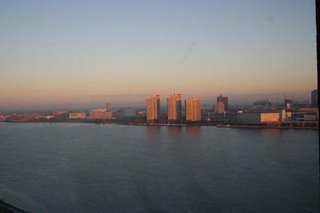
If Windsor and Detroit are sister cities, Windsor is obviously the beautiful sister. What an attractive, green, and clean city this is! I spent more time exploring Windsor than I did anywhere on the rest of my trip except Burlington, and liked what I saw. I had a guided tour all day Sunday courtesy of the Director of Parks, Don Sadler, and his partner Lou Ann Barnett, a professional photographer from whom I could learn a lot, if I could follow her around for a few days. They picked me up Sunday morning and proceeded to show me everything from the incredibly lovely riverside gardens to a couple of nature parks to several recreation parks to distinctive formal gardens to that tallgrass prairie. And I was smitten.
Windsor is a city of around 200,000, and while there have been some hardtimes courtesy of the downturn of the American car manufacturing industry, this is a city that loves its public green spaces. And not only that, the community supports that love with financial backing, so that the parks and green spaces and athletic fields are well tended, beautifully groomed in fact—and done so using green gardening techniques as much as possible. Put a city beside a lovely waterway—and there’s swimming at public spaces along the way—and clean up the waterfront to become a series of parks and gardens, and it’s amazing how people will flock to use it. On weekdays, office workers fill the parking lots as they take a break to walk through the gardens and along the waterfront; on the weekend, it’s family time, with scores of people out with their children, young couples dreaming their way along the waterfront…and there’s no litter to be seen! People actually use the large but discreet garbage bins! I was delighted by that, being accustomed to seeing the disrespect shown in some communities for public spaces.
The riverside gardens include three main areas; Reaume Park and Coventry Gardens, and features something for everyone. Children enjoy hunting through the gardens to find the various topiary sculptures of animals from dogs to dragons; the huge floating fountain, the Charlie Brooks Memorial Peace Fountain, creates more than 2 dozen spray patterns as it throws water high into the air; the gardens are full of imaginative plantings, using a wide variety of annuals, perennials, shrubs, and even tender perennials and tropicals (which go indoors for the winter, of course.) Further along is a wildflower garden, then the Bert Weeks Memorial Garden, built in honour of a former mayor. This place was incredible—well planted with perennial grasses, which were in full bloom and song when I visited, and which provided a wonderful counterpoint to the sound of music from the huge water feature called the reflecting pool. At the river’s edge is an interesting brick structure, which now is used to pump water not to the community but to irrigate the gardens along the river.
the gardens are full of imaginative plantings, using a wide variety of annuals, perennials, shrubs, and even tender perennials and tropicals (which go indoors for the winter, of course.) Further along is a wildflower garden, then the Bert Weeks Memorial Garden, built in honour of a former mayor. This place was incredible—well planted with perennial grasses, which were in full bloom and song when I visited, and which provided a wonderful counterpoint to the sound of music from the huge water feature called the reflecting pool. At the river’s edge is an interesting brick structure, which now is used to pump water not to the community but to irrigate the gardens along the river.
 Naturally, I was entranced by the whole riverside garden experience, but there was far more. Further along Riverside Drive is Odette Sculpture Park, which is dedicated to a generous number of modern art sculptures. There are two totem poles, bronzes of horses and humans, wire sculpture, and my favourite—penguins!
Naturally, I was entranced by the whole riverside garden experience, but there was far more. Further along Riverside Drive is Odette Sculpture Park, which is dedicated to a generous number of modern art sculptures. There are two totem poles, bronzes of horses and humans, wire sculpture, and my favourite—penguins!
One thing about Windsor—it’s a flat, flat city. There are two hills in the entire city, and both of those are manmade, reclaimed areas that are natural parks with trails for runners and cyclists and others to enjoy. We went to the top of both these hills, (Malden and Ganatchio) and could survey not only the city, but across the river to Detroit! Naturally, one of these hills is much loved as a toboggan run in winter—when there is snow that lasts any amount of time, of course, because this is a mild-wintered part of the country.
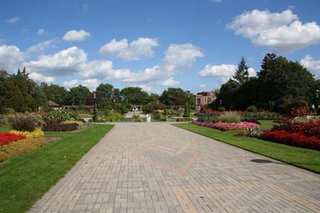 From the wild beauty of Ojibway and Malden and the Ganatchio Trail, we went to a completely different area: Jackson Park, dedicated by Queen Elizabeth some years ago, and featuring formal gardens and walkways (perfect for wedding pictures) and several war memorials to veterans. That was a particularly striking sight—there are two replica planes in one section of the garden, a Spitfire and a Hurricane.
From the wild beauty of Ojibway and Malden and the Ganatchio Trail, we went to a completely different area: Jackson Park, dedicated by Queen Elizabeth some years ago, and featuring formal gardens and walkways (perfect for wedding pictures) and several war memorials to veterans. That was a particularly striking sight—there are two replica planes in one section of the garden, a Spitfire and a Hurricane. 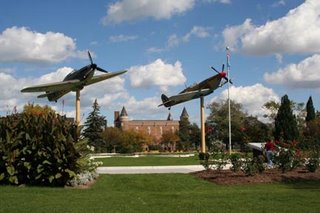 The third, a Lancaster, is being restored and is to be located in another park, but its silhouette has been outlined on the ground under the two planes, a haunting echo and a moving tribute to the sacrifice made by so many. Seems highly appropriate especially given our current state of affairs in Afghanistan.
The third, a Lancaster, is being restored and is to be located in another park, but its silhouette has been outlined on the ground under the two planes, a haunting echo and a moving tribute to the sacrifice made by so many. Seems highly appropriate especially given our current state of affairs in Afghanistan.
There was almost too much to take in all in one day in Windsor—were I planning another trip, I would spend no less than two days in each of the cities I visited on this trip, and more if I could. It would be hard to pick a favourite site, either in Windsor or on the whole trip, so I won’t—I enjoyed all of them for different reasons, as each is very good at what it does.
After an early supper, I returned to my room to download another 150 or so photos, and pack up for a very early morning. Two days on trains, basically, brought me through Ontario and Quebec and back into the Maritimes via the Ocean again. About Miramichi, however, I decided I was getting restless to be on the ground again, and called my longsuffering spouse to meet me in Truro. It’s always wonderful to go away—and this was an exceptionally fine trip—but it’s even more wonderful to see my darling other half standing on the platform waiting for me. And be it ever so humble, there’s no garden quite like our own, is there?

If Windsor and Detroit are sister cities, Windsor is obviously the beautiful sister. What an attractive, green, and clean city this is! I spent more time exploring Windsor than I did anywhere on the rest of my trip except Burlington, and liked what I saw. I had a guided tour all day Sunday courtesy of the Director of Parks, Don Sadler, and his partner Lou Ann Barnett, a professional photographer from whom I could learn a lot, if I could follow her around for a few days. They picked me up Sunday morning and proceeded to show me everything from the incredibly lovely riverside gardens to a couple of nature parks to several recreation parks to distinctive formal gardens to that tallgrass prairie. And I was smitten.

Windsor is a city of around 200,000, and while there have been some hardtimes courtesy of the downturn of the American car manufacturing industry, this is a city that loves its public green spaces. And not only that, the community supports that love with financial backing, so that the parks and green spaces and athletic fields are well tended, beautifully groomed in fact—and done so using green gardening techniques as much as possible. Put a city beside a lovely waterway—and there’s swimming at public spaces along the way—and clean up the waterfront to become a series of parks and gardens, and it’s amazing how people will flock to use it. On weekdays, office workers fill the parking lots as they take a break to walk through the gardens and along the waterfront; on the weekend, it’s family time, with scores of people out with their children, young couples dreaming their way along the waterfront…and there’s no litter to be seen! People actually use the large but discreet garbage bins! I was delighted by that, being accustomed to seeing the disrespect shown in some communities for public spaces.
The riverside gardens include three main areas; Reaume Park and Coventry Gardens, and features something for everyone. Children enjoy hunting through the gardens to find the various topiary sculptures of animals from dogs to dragons; the huge floating fountain, the Charlie Brooks Memorial Peace Fountain, creates more than 2 dozen spray patterns as it throws water high into the air;
 the gardens are full of imaginative plantings, using a wide variety of annuals, perennials, shrubs, and even tender perennials and tropicals (which go indoors for the winter, of course.) Further along is a wildflower garden, then the Bert Weeks Memorial Garden, built in honour of a former mayor. This place was incredible—well planted with perennial grasses, which were in full bloom and song when I visited, and which provided a wonderful counterpoint to the sound of music from the huge water feature called the reflecting pool. At the river’s edge is an interesting brick structure, which now is used to pump water not to the community but to irrigate the gardens along the river.
the gardens are full of imaginative plantings, using a wide variety of annuals, perennials, shrubs, and even tender perennials and tropicals (which go indoors for the winter, of course.) Further along is a wildflower garden, then the Bert Weeks Memorial Garden, built in honour of a former mayor. This place was incredible—well planted with perennial grasses, which were in full bloom and song when I visited, and which provided a wonderful counterpoint to the sound of music from the huge water feature called the reflecting pool. At the river’s edge is an interesting brick structure, which now is used to pump water not to the community but to irrigate the gardens along the river. Naturally, I was entranced by the whole riverside garden experience, but there was far more. Further along Riverside Drive is Odette Sculpture Park, which is dedicated to a generous number of modern art sculptures. There are two totem poles, bronzes of horses and humans, wire sculpture, and my favourite—penguins!
Naturally, I was entranced by the whole riverside garden experience, but there was far more. Further along Riverside Drive is Odette Sculpture Park, which is dedicated to a generous number of modern art sculptures. There are two totem poles, bronzes of horses and humans, wire sculpture, and my favourite—penguins! One thing about Windsor—it’s a flat, flat city. There are two hills in the entire city, and both of those are manmade, reclaimed areas that are natural parks with trails for runners and cyclists and others to enjoy. We went to the top of both these hills, (Malden and Ganatchio) and could survey not only the city, but across the river to Detroit! Naturally, one of these hills is much loved as a toboggan run in winter—when there is snow that lasts any amount of time, of course, because this is a mild-wintered part of the country.
 From the wild beauty of Ojibway and Malden and the Ganatchio Trail, we went to a completely different area: Jackson Park, dedicated by Queen Elizabeth some years ago, and featuring formal gardens and walkways (perfect for wedding pictures) and several war memorials to veterans. That was a particularly striking sight—there are two replica planes in one section of the garden, a Spitfire and a Hurricane.
From the wild beauty of Ojibway and Malden and the Ganatchio Trail, we went to a completely different area: Jackson Park, dedicated by Queen Elizabeth some years ago, and featuring formal gardens and walkways (perfect for wedding pictures) and several war memorials to veterans. That was a particularly striking sight—there are two replica planes in one section of the garden, a Spitfire and a Hurricane.  The third, a Lancaster, is being restored and is to be located in another park, but its silhouette has been outlined on the ground under the two planes, a haunting echo and a moving tribute to the sacrifice made by so many. Seems highly appropriate especially given our current state of affairs in Afghanistan.
The third, a Lancaster, is being restored and is to be located in another park, but its silhouette has been outlined on the ground under the two planes, a haunting echo and a moving tribute to the sacrifice made by so many. Seems highly appropriate especially given our current state of affairs in Afghanistan. There was almost too much to take in all in one day in Windsor—were I planning another trip, I would spend no less than two days in each of the cities I visited on this trip, and more if I could. It would be hard to pick a favourite site, either in Windsor or on the whole trip, so I won’t—I enjoyed all of them for different reasons, as each is very good at what it does.
After an early supper, I returned to my room to download another 150 or so photos, and pack up for a very early morning. Two days on trains, basically, brought me through Ontario and Quebec and back into the Maritimes via the Ocean again. About Miramichi, however, I decided I was getting restless to be on the ground again, and called my longsuffering spouse to meet me in Truro. It’s always wonderful to go away—and this was an exceptionally fine trip—but it’s even more wonderful to see my darling other half standing on the platform waiting for me. And be it ever so humble, there’s no garden quite like our own, is there?
04 October 2006
From rocks to wetlands to neon to Niagara
High on my list of places you gotta go is the Royal Botanical Gardens, located in Burlington/Hamilton. What a great time I had visiting this time. In 2005 I was in Hamilton for PWAC’s Annual General Meeting, and got to see a bit of the gardens, but not nearly enough. This time, however, I got a pretty thorough visit of much of the site, which is actually spread out over several different locales around the edge of Hamilton/Burlington.
Last time, I was at the Rock Gardens in late May, and they were awash in colour from the 100,000 plus bulbs, mostly tulips, planted there. Big sweeps of colour, vibrant and jewellike; now of course that garden is planted with a host of annuals to provide equal drifts of colour, and those will be coming out soon for the bulb planting session. The Rock Garden is neat because it’s set down in this hollow with huge, native rock structures on the hills of the “bowl”—nice dramatic rocks, and since this is part of the Niagara Escarpment, it’s hardly surprising to find rocks there.
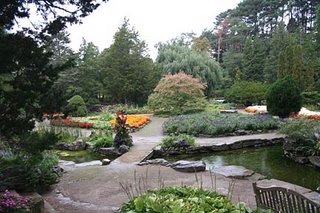
It was built 75 years ago in what was an abandoned gravel pit, using local limestone—a great make-work project to help counteract the grim reality of the Depression. There aren’t only annuals and bulbs here, howeve—there are some wonderful water features, mature trees and shrubs, (including magnolias and flowering cherries, rhodos and azaleas), and lots of steps and terraces to climb and view the garden from. It’s a peaceful and beautiful space, and much loved by the citizens of the area.
The RBG Centre is, of course, the place to start an entire tour of the Gardens. My host Andrew King and I had lunch in the Gardens Café, then headed to the Mediterranean Garden, an indoor collection under glass (and a perfect place to go during the grey days of winter.) There are huge specimens in here, ranging from false agave to banana (at least I think it was a banana!) flamboyant flowering plants such as bouganvillea, passion flower and bird of paradise, a fine display of cacti and succulents, and even wonderful citrus trees (all with fruit on them). Children can enjoy the outdoor Discovery Garden, which has all kinds of wonderful activities for them to help them get interested in gardening early.
Along with the usual displays of plants and structures, the Gardens were playing host to another unique display of beauty while I was there. ZimSculpt, a collection of Zimbabwean sculptures were nestled throughout Hendrie Park, looking like they had always been there--when in fact they were part of a touring exhibit--on its only stop in Canada--from that country, with the curator and three of the sculptors along for the trip, of course. They've spent a month in Burlington, have sold over 100,000 dollars worth of sculpture, and were hard at work making new pieces using single chunks of rock that they brought with them. Watching them was totally fascinating, and the sculptures were gorgeous...the tour is complete now, and they are heading homeward, but hopefully will be back again in the not too distant future.
Out the doors of the Centre, we enjoy the fountain court, where the cheery chiming of water from fountains provides the perfect anodyne to the rumble of nearby traffic. This terraced area is awash with annuals providing late season colour to push away even the dreariest of days—and it was dreary the day I visited. From there we walked into Hendrie Park, which is a huge, sprawling area with more than a dozen different theme gardens. The Centennial Rose Garden takes up a significant part of the Park, and you’d be surprised just how many roses are still blooming quite happily, even as we progress into October.
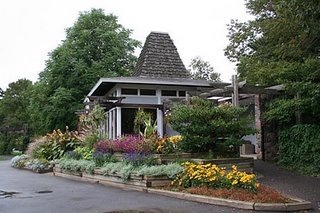
There are themed gardens for herbs and lilies, a wonderful medicinal garden, a clematis collection, more plots for children to enjoy, and the lovely tea house where you can pause and enjoy some refreshments before heading to the wild sanctuary of the woodland park known as Hendrie Valley Sanctuary. I loved this; we hiked down woodland trails, went through a clever fence designed to keep deer out of Hendrie Park proper, then across a lovely boardwalk over the wetlands area. What a pretty, peaceful spot; visitors were feeding wild birds, chipmunks and squirrels on the boardwalk rails, ducks were splashing and diving in a stream through the wetlands, and of course autumn glory was unfolding in the changing colours of hardwoods. Utterly lovely. We could have stayed a while, walked much further, but time was tickin’ by, and so we regretfully left this place and headed off to another site, Laking Garden.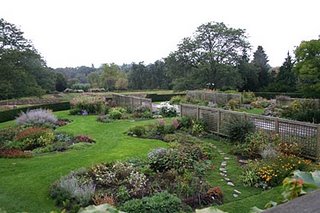
It was beginning to rain quite sincerely when we arrived at Laking, but we did pause to survey the domain from a lookout that gives the perfect view of the terraced gardens. The lowest terrace is currently a work in progress, as the iris beds are being converted from a series of rather dull beds to a more aesthetically appealing showcase for the some 600 cultivars of irises on display. I’d love to see THAT in flower—maybe another year! There’s a lovely old cottage at the top of the terraces, site of the Barbara Laking Heritage garden, which features many heirloom culticars of perennials and shrubs. The central terrace is dedicated to perennials, all kinds of perennials, including many new and improved cultivars. I really, REALLY enjoyed this area, despite the wet—well, I thought Laking in itself was pretty fine, a public spot any city would be proud to have, and yet it was only one section of the RBG.
By now, the rain was sincerely soggy, so my intrepid host suggested, as we had some three hours before my train, that we go off to Niagara to see the falls. It was too wet to go exploring gardens there and we knew we wouldn’t have that much time, but we sallied off down the highway and yakked a mile a minute about many things, while I gawked out windows at things like the Welland Canal, assorted vineyards, and such til we arrived in downtown Niagara Falls.
Well. What a strange place that is. Ever been there? Yikes! Clifton Hill is called the Entertainment and Dining district of Niagara Falls. I have one word to describe it—ultratacky! I’ve never seen so much neon, flashing lights, and bizarre displays enticing visitors; how about Frankenstein eating a burger on top of a fast food joint? King Kong hanging off another site? A wax museum—de rigeur in many tacky tourist traps—and of course, a plethora of casinos and nightclubs, all designed to separate the biker chicks, greaseballs, nearly destitute, nouveau riche and others from their money. I felt like I needed a shower just driving through the area. But you know what? It was all washed away, nearly literally, when we turned the corner and headed down to enjoy 12 dollar parking and the main attraction that gives the city its name—the real, genuine, and totally awesome Niagara Falls.
It’s hard to take a photo up close that shows the true magnificence and power of the Falls. All that energy, sound, fury, colour, cascading over the rapids and down over the dramatic drop to the river below. Utterly, completely mindblowingly wonderful. Never mind the horde of hotels on the hillside overlooking the Falls. Never mind the neon nightmare up the hill. Never mind the hordes of tacky souvenir shops. The falls are worth visiting, any time day or night.
And nyah, nyah, nyah nyah nyah, nyah…the Canadian falls are way, way more impressive than the wimpy American falls nearby. Ours are better than theirs….
Last time, I was at the Rock Gardens in late May, and they were awash in colour from the 100,000 plus bulbs, mostly tulips, planted there. Big sweeps of colour, vibrant and jewellike; now of course that garden is planted with a host of annuals to provide equal drifts of colour, and those will be coming out soon for the bulb planting session. The Rock Garden is neat because it’s set down in this hollow with huge, native rock structures on the hills of the “bowl”—nice dramatic rocks, and since this is part of the Niagara Escarpment, it’s hardly surprising to find rocks there.

It was built 75 years ago in what was an abandoned gravel pit, using local limestone—a great make-work project to help counteract the grim reality of the Depression. There aren’t only annuals and bulbs here, howeve—there are some wonderful water features, mature trees and shrubs, (including magnolias and flowering cherries, rhodos and azaleas), and lots of steps and terraces to climb and view the garden from. It’s a peaceful and beautiful space, and much loved by the citizens of the area.
The RBG Centre is, of course, the place to start an entire tour of the Gardens. My host Andrew King and I had lunch in the Gardens Café, then headed to the Mediterranean Garden, an indoor collection under glass (and a perfect place to go during the grey days of winter.) There are huge specimens in here, ranging from false agave to banana (at least I think it was a banana!) flamboyant flowering plants such as bouganvillea, passion flower and bird of paradise, a fine display of cacti and succulents, and even wonderful citrus trees (all with fruit on them). Children can enjoy the outdoor Discovery Garden, which has all kinds of wonderful activities for them to help them get interested in gardening early.
Along with the usual displays of plants and structures, the Gardens were playing host to another unique display of beauty while I was there. ZimSculpt, a collection of Zimbabwean sculptures were nestled throughout Hendrie Park, looking like they had always been there--when in fact they were part of a touring exhibit--on its only stop in Canada--from that country, with the curator and three of the sculptors along for the trip, of course. They've spent a month in Burlington, have sold over 100,000 dollars worth of sculpture, and were hard at work making new pieces using single chunks of rock that they brought with them. Watching them was totally fascinating, and the sculptures were gorgeous...the tour is complete now, and they are heading homeward, but hopefully will be back again in the not too distant future.
Out the doors of the Centre, we enjoy the fountain court, where the cheery chiming of water from fountains provides the perfect anodyne to the rumble of nearby traffic. This terraced area is awash with annuals providing late season colour to push away even the dreariest of days—and it was dreary the day I visited. From there we walked into Hendrie Park, which is a huge, sprawling area with more than a dozen different theme gardens. The Centennial Rose Garden takes up a significant part of the Park, and you’d be surprised just how many roses are still blooming quite happily, even as we progress into October.

There are themed gardens for herbs and lilies, a wonderful medicinal garden, a clematis collection, more plots for children to enjoy, and the lovely tea house where you can pause and enjoy some refreshments before heading to the wild sanctuary of the woodland park known as Hendrie Valley Sanctuary. I loved this; we hiked down woodland trails, went through a clever fence designed to keep deer out of Hendrie Park proper, then across a lovely boardwalk over the wetlands area. What a pretty, peaceful spot; visitors were feeding wild birds, chipmunks and squirrels on the boardwalk rails, ducks were splashing and diving in a stream through the wetlands, and of course autumn glory was unfolding in the changing colours of hardwoods. Utterly lovely. We could have stayed a while, walked much further, but time was tickin’ by, and so we regretfully left this place and headed off to another site, Laking Garden.

It was beginning to rain quite sincerely when we arrived at Laking, but we did pause to survey the domain from a lookout that gives the perfect view of the terraced gardens. The lowest terrace is currently a work in progress, as the iris beds are being converted from a series of rather dull beds to a more aesthetically appealing showcase for the some 600 cultivars of irises on display. I’d love to see THAT in flower—maybe another year! There’s a lovely old cottage at the top of the terraces, site of the Barbara Laking Heritage garden, which features many heirloom culticars of perennials and shrubs. The central terrace is dedicated to perennials, all kinds of perennials, including many new and improved cultivars. I really, REALLY enjoyed this area, despite the wet—well, I thought Laking in itself was pretty fine, a public spot any city would be proud to have, and yet it was only one section of the RBG.
By now, the rain was sincerely soggy, so my intrepid host suggested, as we had some three hours before my train, that we go off to Niagara to see the falls. It was too wet to go exploring gardens there and we knew we wouldn’t have that much time, but we sallied off down the highway and yakked a mile a minute about many things, while I gawked out windows at things like the Welland Canal, assorted vineyards, and such til we arrived in downtown Niagara Falls.
Well. What a strange place that is. Ever been there? Yikes! Clifton Hill is called the Entertainment and Dining district of Niagara Falls. I have one word to describe it—ultratacky! I’ve never seen so much neon, flashing lights, and bizarre displays enticing visitors; how about Frankenstein eating a burger on top of a fast food joint? King Kong hanging off another site? A wax museum—de rigeur in many tacky tourist traps—and of course, a plethora of casinos and nightclubs, all designed to separate the biker chicks, greaseballs, nearly destitute, nouveau riche and others from their money. I felt like I needed a shower just driving through the area. But you know what? It was all washed away, nearly literally, when we turned the corner and headed down to enjoy 12 dollar parking and the main attraction that gives the city its name—the real, genuine, and totally awesome Niagara Falls.
It’s hard to take a photo up close that shows the true magnificence and power of the Falls. All that energy, sound, fury, colour, cascading over the rapids and down over the dramatic drop to the river below. Utterly, completely mindblowingly wonderful. Never mind the horde of hotels on the hillside overlooking the Falls. Never mind the neon nightmare up the hill. Never mind the hordes of tacky souvenir shops. The falls are worth visiting, any time day or night.

And nyah, nyah, nyah nyah nyah, nyah…the Canadian falls are way, way more impressive than the wimpy American falls nearby. Ours are better than theirs….
01 October 2006
Toronto's Diva gets a facelift
 I’m a trooper when it comes to visiting gardens. After rolling into Toronto at nearly 11 pm, where the highlight of the trip was being met by my son Ryan, (newly moved to Toronto), I was up and going again by 745 the next morning. First I ‘rode the rocket’ of the Toronto subway to Eglinton, where a transfer to a bus took me down the road a few more miles to the Toronto Botanical Gardens at Lawrence Street East. There I found a surprise—these gardens are open to the public at no charge! In the courtyard nearest the main building, a group of seniors were drifting through the movements of tai chi. I wandered around for a little while before being met by my guide for the visit, a very nice man named (I think), Ken—a Friend of the Garden who volunteers regularly at the Music garden downtown at Harbourfront, but who also lives near the TBG and was willing to give up an hour or so of his Saturday morning to squire me around.
I’m a trooper when it comes to visiting gardens. After rolling into Toronto at nearly 11 pm, where the highlight of the trip was being met by my son Ryan, (newly moved to Toronto), I was up and going again by 745 the next morning. First I ‘rode the rocket’ of the Toronto subway to Eglinton, where a transfer to a bus took me down the road a few more miles to the Toronto Botanical Gardens at Lawrence Street East. There I found a surprise—these gardens are open to the public at no charge! In the courtyard nearest the main building, a group of seniors were drifting through the movements of tai chi. I wandered around for a little while before being met by my guide for the visit, a very nice man named (I think), Ken—a Friend of the Garden who volunteers regularly at the Music garden downtown at Harbourfront, but who also lives near the TBG and was willing to give up an hour or so of his Saturday morning to squire me around. Like many aging dowagers, the TBG is going through a period of rejuvenation. But in this case, it’s not liposuction and botox that is bringing this space back to its glory days, but the vision and dedication of its planners and planters. Much of the plantings now on display are new, tucked into the ground this spring, after a massive renovation of the grounds and the main building of the Gardens. There are twelve themed gardens in total, ranging from a very cool herb/kitchen garden, where each year a particular culture’s vegetables will be showcased, a terraced garden, a trial or show garden focusing on choice and sometimes unusual plants suitable for city gardening, a spiral mound (originally meant to be covered in thyme but currently grassed) from which you can view most of the Garden’s layout, and far more. Walkways are wide and most are paved, and there’s a lot to see in a compact locale—just like most Toronto yards, the Garden make the most of its available space.
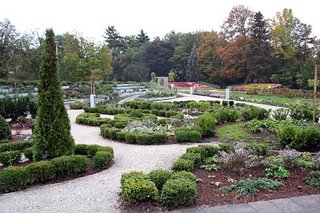
My host said that people are sometimes offput by the fact that the gardens aren’t all as full and lush as they expect—but I think this is actually excellent, because it also gives real gardeners, whether seasoned or new, a look at how a garden develops and grows over a period of time. After all, we all face this, especially when planting perennials, trees and shrubs—things look a little sparse initially. But I thought everything looked excellent. There are marvelous drifts of grasses near the entrance to the parking area; these look like they’ve been here for a while; then as we walk down the stone-paved paths towards the heart of the property, there is a wonderful planting that will, in time, look like a wildflower or prairie meadow planting, featuring some native as well as introduced species. There’s a unique long curving wall, built using a variety of materials from the portion of the building that was torn down for renovating, and planted with sempervivums and other groundcovering plants. Some think this planting resembles a train, or perhaps a slice of the Niagara Escarpment—I just know that it’s quite striking now and will be even moreso next year when it fills in further.
The two carpet bedding displays at one end of the Gardens acknowledge another garden, Edwards Gardens, which is a City of Toronto park. The TBG is a charitable organization, funded by generous patrons and donors around the city, and shares space, as it were, with the neighbouring Edward Gardens.

I didn’t have a whole lot of time to visit Edward, but looked longingly down a hill—one of Toronto’s famous ravines’ at mature trees, a lovely creek, walking trails and much more.
 The Garden Hall itself has areas that can be rented out, whether for weddings or other special events. Ajoining one part of the facility is the Floral Hall Courtyard, a screened in terrace also ideal for weddings and such. About this courtyard, I have to comment, because this is the third site in two days that I’ve seen featuring horsetails in a design. Not the irritating field horsetail, but the scouring rush, Equisetum hyemale, which DOES have a sort of Oriental quality to it and look really quite striking in a dedicated bed—bounded by stone so it can’t jump elsewhere.
The Garden Hall itself has areas that can be rented out, whether for weddings or other special events. Ajoining one part of the facility is the Floral Hall Courtyard, a screened in terrace also ideal for weddings and such. About this courtyard, I have to comment, because this is the third site in two days that I’ve seen featuring horsetails in a design. Not the irritating field horsetail, but the scouring rush, Equisetum hyemale, which DOES have a sort of Oriental quality to it and look really quite striking in a dedicated bed—bounded by stone so it can’t jump elsewhere. My only negative comment about my visit is that I hope that the TBG revises their website soon—it doesn’t display properly, is hard to navigate and has more administrative stuff on it than information about the gardens themselves, which is why I haven’t bothered adding a link to its URL in this entry.
One amusing aside—during my stay at the Fairmont Royal York, I opened a bottle of mineral water in my room, thinking it was the water they provide with their turndown service. Imagine my surprise when my son announced that he’d never SEEN an EIGHT DOLLAR bottle of water before! When I went to check out, I told the clerk to add the bottle to my tab (for Internet service—this is the only hotel I’ve stayed in in months that charges for high speed internet—a black mark on them) but she graciously dropped that charge and seemed somewhat embarrassed at the high price. I was more amused than annoyed, but was also touched by her thoughtfulness.
There are many more gardens throughout the city, including at the famed Casa Loma, which I'd originally been scheduled to visit but which was just not possible in the time allowed. Maybe I'll go some other time, although Toronto gets more than enough press without needing any from me. And yes, I'll confess right here--Toronto is still not my favourite city by a long shot, even if my son does live there!
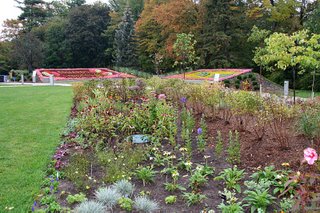
A leader first, a gardener at heart
I honestly didn’t know what to expect when I arrived in Ottawa, en route to visiting Kingsmere, Willam Lyon Mackenzie King’s estate, located in the heart of Gatineau Park, across the river from our nation’s capital. I had no idea that King, prime minister of Canada through three separate terms between 1921 and 1948, had been a lover of gardening since a young child, and at one time had wanted to be a landscaper. However, his parents also instilled in him a desire to serve his country, and hence his venture into political endeavours. We know that MacKenzie King was a dedicated Liberal who did much for this country—and I can’t help but think he spins in his grave when he sees what that bunch of Alliance wolves in cheap conservative clothing is doing to the country that he loved and served so well. Not a perfect leader, of course, as none are. When he died in 1950, King left his estate to the people of Canada.
After a not bad luncheon (though the service was abysmal) at the Moorside Tea Room, located in one of the summer houses on the estate, I went with my guide, Annie, around part of the estate. This area is at the top of quite a steep hill, much loved by cyclists, joggers, cross country skiers, and other outdoorsy types, and encompasses some 600 acres in total, some of it woodland, some of it resembling an English gentleman’s country estate—as King was a great fan of all things British, but more of a Romantic in tendancies than a late Victorian or Georgian. The houses didn’t particularly interest me, as architecture and old dishes, etc, aren’t particularly my thing but I did, of course, love the typewriter, on which King wrote many of his speeches.
but I did, of course, love the typewriter, on which King wrote many of his speeches.
What won my heart, where this interesting gentleman was concerned, was the wonderful stone walls throughout the property. King had these built during the depression, hiring local, unemployed individuals to do the work and earn a wage they would have otherwise been unlikely to find. The walls feature local indigenous rocks, mostly igneous in type, though I am no geologist so can’t really say what all of them are. Just that they were beautiful with rain on them.
Yeah, did I mention it was raining? Fortunately, Annie had provided me with both a jacket and an umbrella, but at times my lens did get smattered with water.
The perennial borders at the property are past their full glory, but still showing good colour, especially against the flaming backdrop of the hardwoods, which are just beginning to get really beautiful. This is a wonderful place to visit, to stroll across well kept grounds with all sorts of mature trees, as well as interesting stone ruins and relics and statuary that King had brought to the property and added to the landscaping. One long garden especially delighted me. At the top of it, (as it sweeps down a hill) is a massive piece of igneous stone, part of the local geology of an escarpment—a primitive, millions of year old nod to the country’s natural history and beginnings. Then there is a long English style perennial border, acknowledging that country’s place in our country’s development;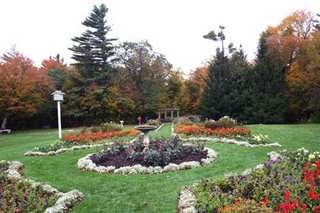 a stone archway which is a window on the woodlands looks down at native plants and natural plantings and a wonderful rock garden featuring alpine and hardy rock garden plants.
a stone archway which is a window on the woodlands looks down at native plants and natural plantings and a wonderful rock garden featuring alpine and hardy rock garden plants.
After this part of the tour, I was met by Francois LeDuc, who squired me around much of Gatineau Park proper. The park is over 380 square kilometers in size, with all kinds of landforms and geography, flora and fauna. At several places along the roads, there are incredible lookouts, the most dramatic one being at the top of the Escarpment looking down into the valley around Hull, Gatineau, Ottawa and Aylmer. And there are serious foliage fireworks happening—wow!
We took a drive to Meech Lake—yes, THAT Meech Lake, site of the failed accord—and followed the winding road along the series of three lakes in a chain. (there are something like 50 lakes in the park). Harrington Lake is site of the summer home of the prime minister, but we didn’t go up to the gates. Just as well, as I’d have had to show some sign of disrespect for that squinty eyed thug from Alberta…What struck me, once Francois drew it to my attention, was the careful pruning of the trees along the shores on the far side of the lakes…
…which, of course, is not pruning at all, at least not by human hands, but rather, by the teeth of deer.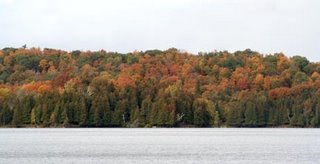 We saw a doe and two fawns on the roadside as we came down from the King estate, incidentally, as unconcerned about us as if we weren’t even there.
We saw a doe and two fawns on the roadside as we came down from the King estate, incidentally, as unconcerned about us as if we weren’t even there.
While I enjoyed this visit very much, I was also happy to get on the train again and head off down the road to Toronto. I’m so totally impressed with the service of VIA Rail—especially in first class. Let me give you all the menu from supper between Ottawa and Taranna—
Appetiser: melon and proscuitto; your choice of bread roll (with butter, not slimy margarine)
Main course; choice of three; I opted for braised beef, with tiny roasted potatoes, and a vegetable medly of fennel (delicious!), green beans, parsnips and red peppers; wine was an Ontario Riesling, I think (I forgot to write that down)
Dessert—an apple caramel cake, and then this chocolate in a chocolate cup—divine!
The staff came with wine several times, and then with liqueurs, even—Grand Marnier, cognac, Baileys, Tia Maria….I declined on that, but next time…I may treat myself.
And the staff is simply fantastic. This is an awesome way to travel!
Stiill, this is a hectic pace. Three gardens down, three cities to go.
After a not bad luncheon (though the service was abysmal) at the Moorside Tea Room, located in one of the summer houses on the estate, I went with my guide, Annie, around part of the estate. This area is at the top of quite a steep hill, much loved by cyclists, joggers, cross country skiers, and other outdoorsy types, and encompasses some 600 acres in total, some of it woodland, some of it resembling an English gentleman’s country estate—as King was a great fan of all things British, but more of a Romantic in tendancies than a late Victorian or Georgian. The houses didn’t particularly interest me, as architecture and old dishes, etc, aren’t particularly my thing
 but I did, of course, love the typewriter, on which King wrote many of his speeches.
but I did, of course, love the typewriter, on which King wrote many of his speeches. What won my heart, where this interesting gentleman was concerned, was the wonderful stone walls throughout the property. King had these built during the depression, hiring local, unemployed individuals to do the work and earn a wage they would have otherwise been unlikely to find. The walls feature local indigenous rocks, mostly igneous in type, though I am no geologist so can’t really say what all of them are. Just that they were beautiful with rain on them.
Yeah, did I mention it was raining? Fortunately, Annie had provided me with both a jacket and an umbrella, but at times my lens did get smattered with water.
The perennial borders at the property are past their full glory, but still showing good colour, especially against the flaming backdrop of the hardwoods, which are just beginning to get really beautiful. This is a wonderful place to visit, to stroll across well kept grounds with all sorts of mature trees, as well as interesting stone ruins and relics and statuary that King had brought to the property and added to the landscaping. One long garden especially delighted me. At the top of it, (as it sweeps down a hill) is a massive piece of igneous stone, part of the local geology of an escarpment—a primitive, millions of year old nod to the country’s natural history and beginnings. Then there is a long English style perennial border, acknowledging that country’s place in our country’s development;
 a stone archway which is a window on the woodlands looks down at native plants and natural plantings and a wonderful rock garden featuring alpine and hardy rock garden plants.
a stone archway which is a window on the woodlands looks down at native plants and natural plantings and a wonderful rock garden featuring alpine and hardy rock garden plants. After this part of the tour, I was met by Francois LeDuc, who squired me around much of Gatineau Park proper. The park is over 380 square kilometers in size, with all kinds of landforms and geography, flora and fauna. At several places along the roads, there are incredible lookouts, the most dramatic one being at the top of the Escarpment looking down into the valley around Hull, Gatineau, Ottawa and Aylmer. And there are serious foliage fireworks happening—wow!

We took a drive to Meech Lake—yes, THAT Meech Lake, site of the failed accord—and followed the winding road along the series of three lakes in a chain. (there are something like 50 lakes in the park). Harrington Lake is site of the summer home of the prime minister, but we didn’t go up to the gates. Just as well, as I’d have had to show some sign of disrespect for that squinty eyed thug from Alberta…What struck me, once Francois drew it to my attention, was the careful pruning of the trees along the shores on the far side of the lakes…
…which, of course, is not pruning at all, at least not by human hands, but rather, by the teeth of deer.
 We saw a doe and two fawns on the roadside as we came down from the King estate, incidentally, as unconcerned about us as if we weren’t even there.
We saw a doe and two fawns on the roadside as we came down from the King estate, incidentally, as unconcerned about us as if we weren’t even there. While I enjoyed this visit very much, I was also happy to get on the train again and head off down the road to Toronto. I’m so totally impressed with the service of VIA Rail—especially in first class. Let me give you all the menu from supper between Ottawa and Taranna—
Appetiser: melon and proscuitto; your choice of bread roll (with butter, not slimy margarine)
Main course; choice of three; I opted for braised beef, with tiny roasted potatoes, and a vegetable medly of fennel (delicious!), green beans, parsnips and red peppers; wine was an Ontario Riesling, I think (I forgot to write that down)
Dessert—an apple caramel cake, and then this chocolate in a chocolate cup—divine!
The staff came with wine several times, and then with liqueurs, even—Grand Marnier, cognac, Baileys, Tia Maria….I declined on that, but next time…I may treat myself.
And the staff is simply fantastic. This is an awesome way to travel!
Stiill, this is a hectic pace. Three gardens down, three cities to go.
Montreal's Other Masterpiece
Montreal’s second masterpiece

It’s a fairly long bus ride through the congestion of downtown Montreal, from the Midtown Holiday Inn (where I had to pout and threaten to call the trip organizer when I came to check in at 8 am after my 21 hour train ride before I could get my room) to the haven of tranquility that is the Jardin Botanique Montreal, or the Montreal Botanical Garden
Even though my energy was somewhat flagging after the train trip and then a spectacular time at Flora, I girded up my loins and my camera and prepared to see what this 75 year old public space had to offer.
And the answer is, quite a lot, of course.
From the traditional carpet bedding arrangement of annuals that greet visitors at the main entrance, to the zenful tranquility of the Japanese and Chinese gardens, from the rich woodlands of the Leslie rhododendron gardens to the flamboyant displays of perennials, childrens gardens and other themed gardens, this is a marvelous, and obviously well-utilized public space.
The Gardens were the dream of Brother Marie-Victorin back in the mid 1920s. (Incidentally, Agriculture Canada’s hardy rose series includes AC Marie-Victorin, a disease-resistant shrub rose introduced back in 1998.) When the dream was about to become a reality, unemployed people in Quebec were hired to build what has become a marvelous tribute to plants in the heart of the city.
They did well, and the dream continues to this day.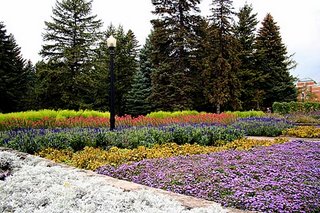
Currently, there’s a remarkable Chinese lantern show going on at the Gardens. While it really gets going at dusk and onwards, it’s worth visiting the Gardens at any time of the day just to see the incredible craftsmanship of these lanterns. They’re more than just your basic pagoda style lanterns, believe me! There are birds, fish, dragons, mythical creatures, lotus, people, all sculpted by artisans in Shanghai, China from silk specially treated to be water resistant, and the theme this year is celebrating Chinese holidays.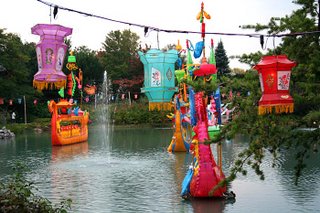 So you’ll see a dragon boat, a dragon dance, kites, and much, much more The colours are vibrant beyond words, and you can’t help but leave the garden feeling both relaxed and exhilarated at this glimpse of genuine Chinese culture. Incidentally, the Chinese garden at the Montreal Botanical Garden is apparently the largest one outside of Asia—quite an accomplishment, and one to be applauded.
So you’ll see a dragon boat, a dragon dance, kites, and much, much more The colours are vibrant beyond words, and you can’t help but leave the garden feeling both relaxed and exhilarated at this glimpse of genuine Chinese culture. Incidentally, the Chinese garden at the Montreal Botanical Garden is apparently the largest one outside of Asia—quite an accomplishment, and one to be applauded.
Bravo, Montreal, for all your horticultural triumphs.
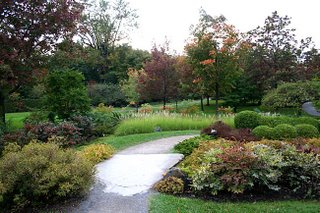

It’s a fairly long bus ride through the congestion of downtown Montreal, from the Midtown Holiday Inn (where I had to pout and threaten to call the trip organizer when I came to check in at 8 am after my 21 hour train ride before I could get my room) to the haven of tranquility that is the Jardin Botanique Montreal, or the Montreal Botanical Garden
Even though my energy was somewhat flagging after the train trip and then a spectacular time at Flora, I girded up my loins and my camera and prepared to see what this 75 year old public space had to offer.
And the answer is, quite a lot, of course.

From the traditional carpet bedding arrangement of annuals that greet visitors at the main entrance, to the zenful tranquility of the Japanese and Chinese gardens, from the rich woodlands of the Leslie rhododendron gardens to the flamboyant displays of perennials, childrens gardens and other themed gardens, this is a marvelous, and obviously well-utilized public space.
The Gardens were the dream of Brother Marie-Victorin back in the mid 1920s. (Incidentally, Agriculture Canada’s hardy rose series includes AC Marie-Victorin, a disease-resistant shrub rose introduced back in 1998.) When the dream was about to become a reality, unemployed people in Quebec were hired to build what has become a marvelous tribute to plants in the heart of the city.
They did well, and the dream continues to this day.

Currently, there’s a remarkable Chinese lantern show going on at the Gardens. While it really gets going at dusk and onwards, it’s worth visiting the Gardens at any time of the day just to see the incredible craftsmanship of these lanterns. They’re more than just your basic pagoda style lanterns, believe me! There are birds, fish, dragons, mythical creatures, lotus, people, all sculpted by artisans in Shanghai, China from silk specially treated to be water resistant, and the theme this year is celebrating Chinese holidays.
 So you’ll see a dragon boat, a dragon dance, kites, and much, much more The colours are vibrant beyond words, and you can’t help but leave the garden feeling both relaxed and exhilarated at this glimpse of genuine Chinese culture. Incidentally, the Chinese garden at the Montreal Botanical Garden is apparently the largest one outside of Asia—quite an accomplishment, and one to be applauded.
So you’ll see a dragon boat, a dragon dance, kites, and much, much more The colours are vibrant beyond words, and you can’t help but leave the garden feeling both relaxed and exhilarated at this glimpse of genuine Chinese culture. Incidentally, the Chinese garden at the Montreal Botanical Garden is apparently the largest one outside of Asia—quite an accomplishment, and one to be applauded. Bravo, Montreal, for all your horticultural triumphs.

Subscribe to:
Posts (Atom)
Search Bloomingwriter

Custom Search
